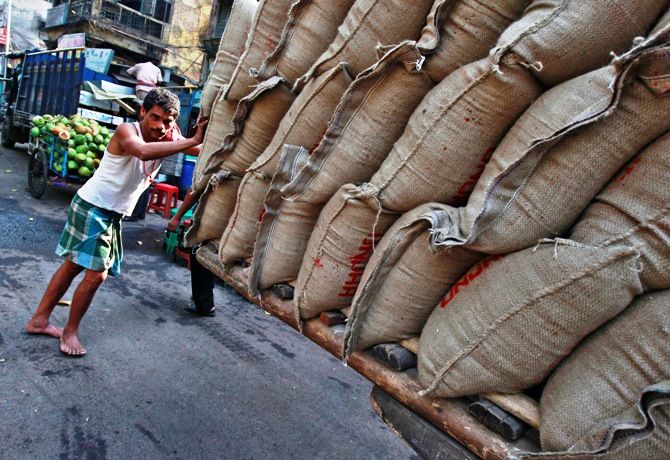 Policy pre-requisites for corporate earnings growth are being ignored
Policy pre-requisites for corporate earnings growth are being ignored
The fourth quarter of the last financial year, 2014-15, was an unmitigated disaster for Indian companies.
Even after adjusting for extraordinary items, profits for the universe of the top 1,600 companies listed on the stock exchanges shrank by 19 per cent year on year.
Profit growth for the blue chips on the Nifty was not very different; for the Sensex, the fall was around nine per cent.
(All these numbers, and those that follow, exclude banks and financial companies, as is the convention.
They are also marginally sensitive to exactly how you account for one-time write-offs, and so on.) Over the entire financial year, Sensex companies recorded no profit growth -- the first time that’s happened in a decade and half, if you exclude the crisis year of 2008-09.
We’re in the middle of the season in which results are declared for the first quarter of this financial year, 2015-16, and the early news is not encouraging.
Remember, the first quarter of both 2014-15 and 2013-14 showed strong corporate profit growth; 32 per cent for those 1,600 companies in Q1 2014-15, and 33 per cent in Q1 2013-14.
This helped gross value added -- and thus gross domestic product -- to post a respectable growth recovery in each of those quarters.
But, as this newspaper reported on Monday, the 215 companies that have reported results so far show net profit growth of only five per cent; for the 14 Nifty companies that have declared first-quarter results so far, profit growth is only 4.2 per cent.
This may, of course, still change; the majority of companies are yet to declare their results.
But the signs aren’t good.
The Nikkei India purchasing manager’s index measure of output (PMI output) fell below 50 for the first time in June 2015 since the new government took over last May.
Both Crisil and Edelweiss, in reports issued in early July, predicted an around two per cent dip in profits in the first quarter.
Should one still be 'bullish on India', as I keep on getting asked by investors passing through Delhi?
Well, the question isn’t really clear.
In the short term, I don’t think anyone can reasonably expect a solid recovery in corporate earnings.
True, even absent that, share indices might still increase -- even given high price-earnings multiples – because the rest of the emerging-markets world is presently in such a mess, and so foreign capital might flow into Indian shares regardless.
But without a recovery in earnings, it’s very difficult to be optimistic in the medium term, once stability returns to the rest of the world, and profit growth returns to Europe after five years.
(There have been several positive surprises in first-quarter corporate results from that troubled continent.)
The long term is, of course, another matter.
Let’s look at the pros and cons.
The biggest 'pro'-India argument seems to be, essentially, reversion to the mean.
Profit margins are below their historic levels, measured in various different ways.
According to Morgan Stanley, the earnings margin for non-finance companies (before interest, depreciation, taxes and amortisation) was 25 per cent in the May 2007 quarter; it’s hovering around or just above19 per cent today.
In the boom years, from 2003 to 2008, earnings per share grew at about 20 per cent (annually, compounded); since then, at about one per cent (according to Franklin Templeton).
Many people find the 'mean reversion' argument persuasive.
I do not; I think this genuinely underestimates the possibility that there has been a structural alteration in the nature of corporate earnings since perhaps 2008, and particularly since 2012.
A blind faith in reversion to the historic mean presupposes the same economic model for the corporate sector, calibrated similarly, applies in 2003 and in 2015.
This is simply not the case.
One argument is that margins will have to rise, since India is a net commodity importer, and we seem to be beginning a long period of low commodity prices. In this newspaper, Akash Prakash has estimated the decline in petroleum, palm oil, coal and fertiliser prices as together saving India $75 billion on the import bill.
Certainly, this positive supply shock has got to make a difference.
But I’d argue much of the positive impact has been expended in its moderation of inflation, and in giving the government fiscal room.
In addition, while there may be a worldwide decrease in commodity prices, in India, commodity prices have moved in the opposite direction structurally.
After decades of subsidised natural resources, many Indian companies will have to pay high prices -- in some cases, well above notional 'market' prices -- for those resources.
In truth, we already know, at this point, what needs to be attended to in order to restore earnings growth -- which I should not need to add, is the first step towards greater value-added and GDP growth, more tax revenue for social-sector spending, and a job-creating expansion of the private sector.
We know, because we now understand and accept – after the noise and obfuscation of the UPA years, which blinded analysts and columnists alike to the real problem -- what has broken down.
First: there will be no sustained earnings recovery unless investment recovers.
The sharp drop in private fixed capital formation is the crucial component of the slowdown in GDP; also, an increase in investment -- when fuelled by proper credit -- raises earnings disproportionately.
But an investment recovery depends on four things: first, on the absence of excess capacity; second, on the recovery of demand; third, on credit being available and not prohibitively expensive; and fourth, on the presence of a clear and manageable risk-return profile.
At the moment, not one of these four exists.
On the first point, RBI surveys suggest capacity utilisation is just under 10 percentage points below what it was in early 2011; the seasonally adjusted trend is still downward.
Unless existing capacity looks like it’s being stretched, nobody will invest.
But without a demand recovery – the second point -- why would over-capacity end? Demand cannot come in the short to medium term from exports, given anaemic world growth.
It cannot come from domestic household consumption, since rural wages – the engine of recent demand growth – have collapsed. In what has to be the gloomiest of signals, for the first time in a decade Coca-Cola cut production, in the quarter ended June.
The third point is knottiest, especially in political-economy terms.
Most sectors that you rely on for investment are over-laden with debt; for infrastructure operators, in 2014-15, debt as a percentage of sales was a startling 256 per cent.
Overall, interest costs grew 10 per cent last financial year; for the early reporters, interest costs went up 19 per cent in the first quarter of 2015-16.
So you need to clear up these balance sheets; in effect, this means some powerful industrialists will have to lose value, or control.
Meanwhile, to get credit moving to the private sector, you need to, first, convince RaghuramRajan the inflation monster is dead; and, second, clean up public-sector banks’ books. For the second part, at least, the government has no coherent plan.
But the most worrying long-term signal is the fourth.
Investors, especially those who invest in real assets on the ground, may be willing to overlook any number of short- or medium-term obstacles if they were convinced that they could participate in the long-term India growth story.
But this depends crucially on trust: trust in a secure contracting, regulatory and tax environment.
The last boom was fuelled by hope that uncertainty was a thing of the past, and government would look the other way because investment and growth was so important.
The years since 2011 have shown that model is broken. It needs to be replaced by a more modern institutional structure that will -- regardless of the party or individual in power -- assure investors that they will not lose big and unpredictably, for no fault of their own.
This requires administrative reform -- of taxation, and of various sector regulators, just to start off with.
But this crucial prerequisite is not even on the government’s agenda.
It is not a coincidence that India has, for the first time in a decade, shown its steepest decline in a decade over the last year in AT Kearney’s FDI confidence index, dropping out of the top 10 for the first time since 2002.
Narendra Modi is running out of time and goodwill; his government needs to focus more.
Image: A labourer pushes a hand cart loaded with sacks of rice at a wholesale market in Kolkata. Photograph: Rupak De Chowdhuri/Reuters










